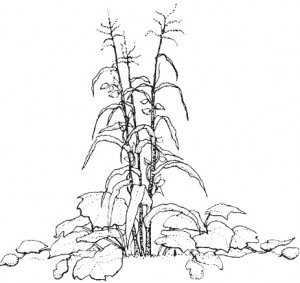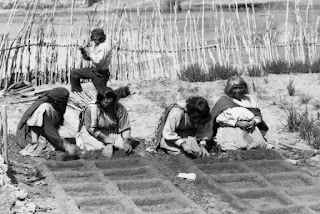By Irene Shonle, El Paso County Extension
 |
| Three sisters illustration (from gardening.cals.cornell.edu) |
This coming summer I have decided to try growing the traditional
grouping of crops called the Three Sisters – corn, beans, and squash. This
is one of the oldest companion planting groupings, first planted by Native
Americans in many different regions. It
is rich in tradition and indigenous knowledge, and can produce a lot of food.
The idea is that the corn provides the trellis for the beans, the beans provide
nitrogen for the hungry corn, and the squash shades the ground and reduces both
water needs and weed seeds.
I have been growing beans and squash for a while now, but
had avoided corn due to the high numbers of raccoons in my area. Supposedly, the combination of the prickly
squash leaves and the raspy, tangly bean vines reduces raccoon visitation. We shall see -- I have the perfect conditions
to test this concept.
For the three sisters, it is traditional to use a flour or popping corn
with taller stalks, a pole bean, and a squash. Many sweet corn varieties don’t
have sturdy enough stalks, and bush beans do not climb up the corn stalks. I
decided to go with a dry bean rather than a green bean, because I don’t want to
be wading into the plot on a daily basis to pick green beans. Sometimes a fourth sister is planted, which is
traditionally a sunflower or a bee plant. I have both growing in my yard, and they will
probably be on the edge of the three sisters area as well as elsewhere in the
garden. These help to draw in pollinators.
It’s been fun figuring out what specific varieties I will
grow. I do not have an easy way to grind flour, but I am a popcorn fan, so that’s
what I decided to go with. Glass gem has irresistibly beautiful multi-hued
kernels, and grows at least 6 feet tall. It’s also supposed to make yummy popcorn,
and can double as a decoration. For the
beans, I want a variety that is harder to find in stores, so I am currently
leaning towards the Hopi red bean, which is supposed to make wonderful
chile. I considered Gigante beans, which
I would really like to try, but I have a feeling that they may be a little too
exuberant. Maybe I’ll try growing a few
up some of my giant sunflowers (they were 15’ tall last summer), if I can find the
seeds (they are hard to come by in this country- I may have to resort to ordering
a pound of beans intended for eating).
Finally, for the squash variety, I will likely plant a couple of summer squash
varieties and perhaps either a Lakota squash (which is a cultivar derived from a
landrace grown by Native Americans in Nebraska and crossed with a Hubbard: https://digitalcommons.unl.edu/cgi/viewcontent.cgi?article=1637&context=agronomyfacpub and somewhat deceptively named: https://medium.com/@MisterOctober/the-lakota-squash-is-a-regrettable-deception-ecd549cb73a5)
or a pink banana squash.
How to grow:
Test your soil first. Corn is a heavy nitrogen feeder (even
with nearby beans), and squash will be more productive with fertile soil. Adding compost before planting can be helpful
to provide a little extra water-holding capacity and to improve soil structure
and a add a few nutrients.
 |
| Zuni waffle garden. Photo Credit: A:shiwi A:wan Museum Photo Archives |
There are many, many different suggestions for the layout for planting, with different layouts traditional to different areas of the country. Because I live in a hot, dry area, I intend to use the traditional Zuni waffle garden design to conserve water. The waffles are created with raised soil edges, and they are almost the opposite of raised beds.
Probably one of the biggest considerations for the planting
design is to plant the corn in blocks so they can become adequately pollinated. Also, grow only one variety of corn to avoid
cross-pollination.
 |
| Three sisters planting diagram (c=corn, b=bean, s=squash) |
I am going to plant in a 15x15’ area, with 9 ‘waffle’
squares. In the center of every other
waffle, I will plant the corn in a circle about 18’ diameter, and will plant 5
seeds of corn, with one in the middle, and the rest evenly spaced. There will
be five blocks of corn, which should provide reasonable pollination. The squash
will go in alternating waffle squares (so, four squares).
Once the corn is 4” high, I will plant the beans (one per corn plant). It is a good idea to soak the corn and bean seeds before planting for at least 8 hours.

Thanks Irene, looking forward to your report. I printed this out and will try it. I also have a raccoon problem so hope the prickly squash will deter them!
ReplyDeleteHere's hoping! I also suspect going with a popcorn rather than a sweet corn might also help matters. Please report back with your experience as well.
DeleteGreat blog!!! I am excited to try this configuration!! Thank you!!
ReplyDeleteI have actually solve the problem (if you are willing to forego sweet corn). I plant the three sisters with popcorn, usually one of the blue corn or glass gem gorgeous varieties. The raccoons have not gone after the popcorn at all, it it provides the structure for the beans. I'm always experimenting with which variety of squash to plant, but I've settled on purple pole beans — the green ones have been harder to find!
ReplyDeleteMy mom (81yo) always planted her garden in a waffle pattern to hold water in. It took me well into my 40s to get how great works, esp in times when water is limited.
ReplyDeleteThank you for sharing this with us. Extra thanks for the images!
ReplyDeleteAn electric fence (2 strands - 1 about 6 inches above the soil and the next another 6 inches) absolutely keeps racoons out of corn, which is a favorite as you know. This may not be practical in some locations but it has worked in unincorporated Boulder county for over 20 years.
ReplyDelete